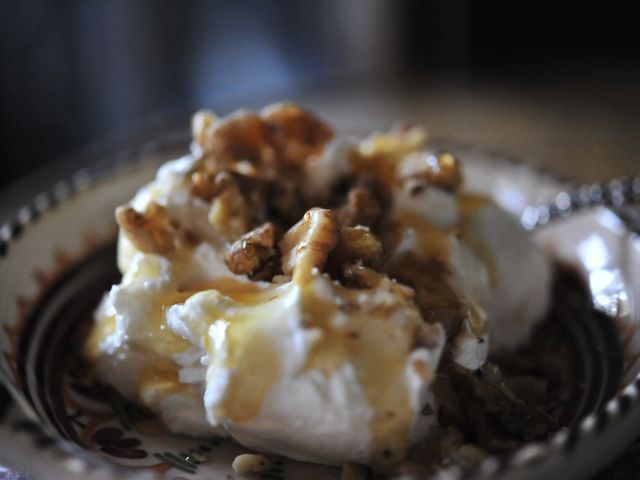4.13.11 Crème de la Crème
Certain foods just have a universal appeal. Consider the dumpling, for instance. It's found in so many cultures, this rose by any other name: knedlíky (Czech), kreplach (Jewish), pantrucas (Chile), manti (Armenia), ravioli (Italy), buuz (Mongolia), pangsit (Indonesia), dim sum (China), gyoza (Japan), mandu (Korea)...the list goes on and on. Yogurt—and soured milk of all kinds—may not be quite as common, especially given that many African and Asian countries don't do dairy, but among those that do it's a deeply-held tradition. From straight-up yogurt to crème fraîche to quark to ricotta to paneer to Mexico's indigenous Nahuatl jocoque árabe, people have long been introducing bacteria or acid to milk with delectable results. Greek yogurt has become hugely popular in this country over the last few years, thanks in no small part to the ubiquitous Fage (pronounced "fa-yeh") brand and now Chobani, too. It's simply yogurt which has been strained to remove the whey, giving it a much denser, creamier texture. Sometimes this style of yogurt is even enriched with extra butterfat or powdered milk.

labne: an ancient and perfect food
In the Middle East, where it's a traditional Bedouin food also known as labne, labneh, labni or lebni (all from the Semitic for "white"), it's an even more extreme version: very thick, somewhere between the consistency of Greek yogurt and cream cheese. It's a popular mezze dish and sandwich ingredient. Besides being used fresh, it can be dried and then formed into balls, sometimes covered with herbs or spices, and stored in olive oil. Milk from camels and other animals is used in labne production in Saudi Arabia and other Persian Gulf countries, but what we see is mainly from cow.
Recently, at Marlow & Daughters in Brooklyn, I did find a strained sheep's milk yogurt that was quite creamy and wonderful, though nowhere near as thick as true labne.High in protein and calcium and low in fat, especially given its creaminess, labne makes a wonderful substitute for crème fraîche or sour cream, without being too heavy to eat by the spoonful. Try it for breakfast with roasted walnuts, fresh or dried fruit and a swirl of good local honey. Or for lunch in a pita with some fresh tomatoes and a few chickpeas. Plop a spoonful on top of lentils or spinach soup. Thin it with a little water and drizzle it on fish tacos. Stir in chopped mint, cilantro, parsley and a dollop of good olive oil and scoop it up with toasted pita. Other foods it pairs well with: oil-cured black olives; sumac; lamb chops; roasted apricots; fresh berries; pomegranate molasses...
Recently, at Marlow & Daughters in Brooklyn, I did find a strained sheep's milk yogurt that was quite creamy and wonderful, though nowhere near as thick as true labne.High in protein and calcium and low in fat, especially given its creaminess, labne makes a wonderful substitute for crème fraîche or sour cream, without being too heavy to eat by the spoonful. Try it for breakfast with roasted walnuts, fresh or dried fruit and a swirl of good local honey. Or for lunch in a pita with some fresh tomatoes and a few chickpeas. Plop a spoonful on top of lentils or spinach soup. Thin it with a little water and drizzle it on fish tacos. Stir in chopped mint, cilantro, parsley and a dollop of good olive oil and scoop it up with toasted pita. Other foods it pairs well with: oil-cured black olives; sumac; lamb chops; roasted apricots; fresh berries; pomegranate molasses...
Labne
produces about 6 ounces of labne, plus whey
- — 1 quart (32 ounces) plain yogurt, ideally organic whole cow's or sheep's milk
Stir yogurt until completely smooth. Set a mesh colander over a bowl and line with cheesecloth or a thin cotton dish towel (or very thick paper towels). Place yogurt in colander and leave to drain in the fridge for at least 24 hours, stirring occasionally to encourage even draining.
Transfer labne and whey to separate covered containers for storage.
 Download Recipe
Download Recipe







6 Comments